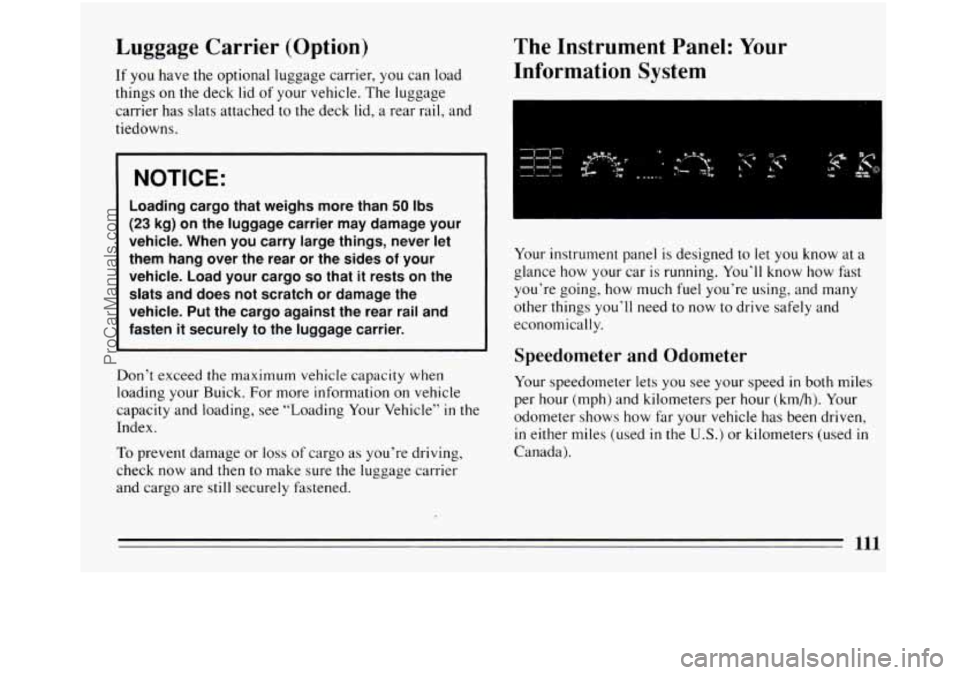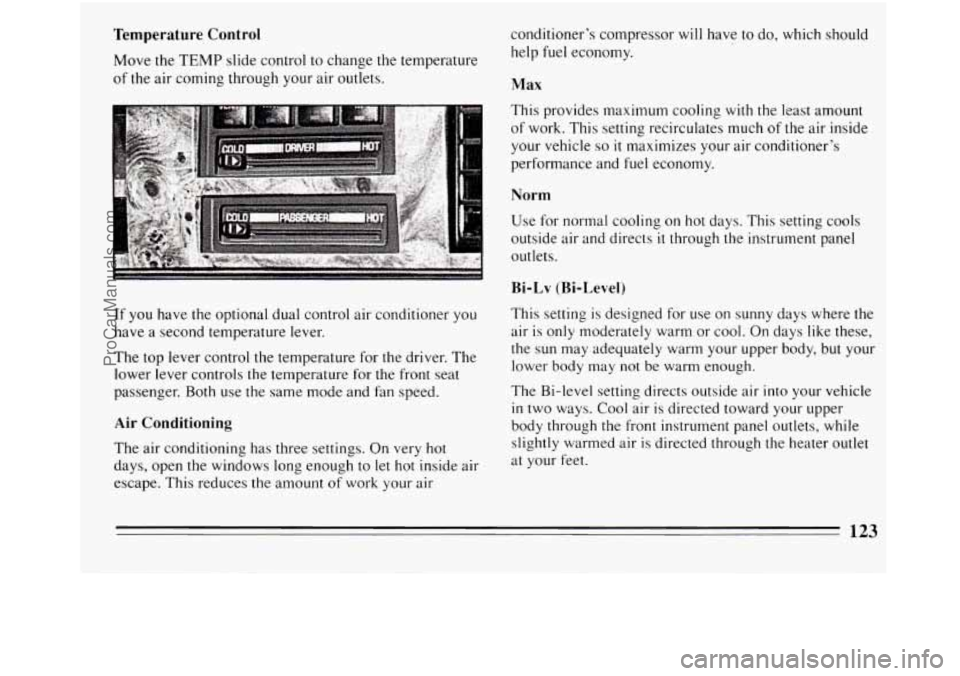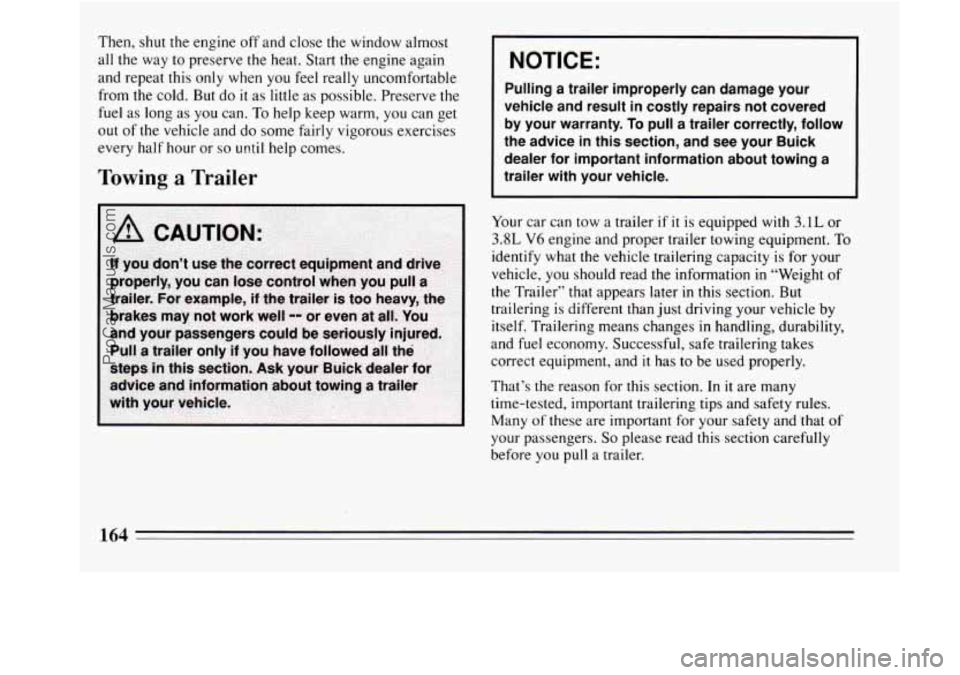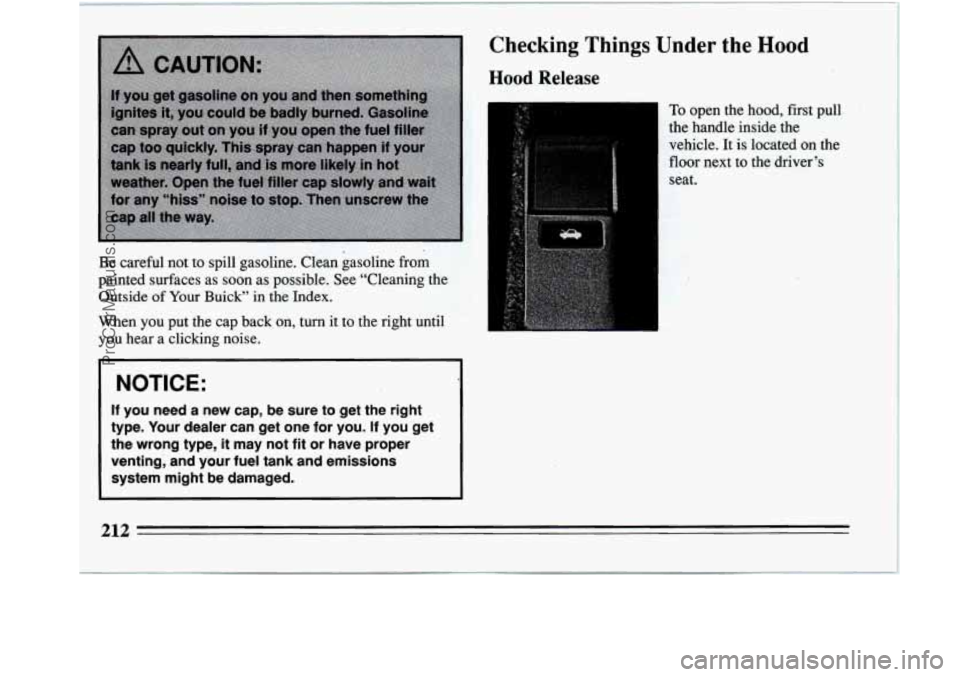1994 BUICK REGAL fuel cap
[x] Cancel search: fuel capPage 113 of 308

Luggage Carrier (Option)
If you have the optional luggage carrier, you can load
things on the deck lid of your vehicle. The luggage
carrier has slats attached to the deck lid, a rear rail, and
tiedowns.
NOTICE:
Loading cargo that weighs more than 50 Ibs
(23 kg) on the luggage carrier may damage your
vehicle. When you carry large things, never let
them hang over the rear or the sides of your
vehicle. Load your cargo
so that it rests on the
slats and does not scratch
or damage the
vehicle. Put the cargo against the rear rail and
fasten
it securely to the luggage carrier.
Don’t exceed the maximum vehicle capacity when
loading your Buick. For more information on vehicle
capacity and loading, see “Loading Your Vehicle”
in the
Index.
To prevent damage or loss of cargo as you’re driving,
check
now and then to make sure the luggage carrier
and cargo are still securely fastened.
The Instrument Panel: Your
Information System
I
Your instrument panel is designed to let you know at a
glance how your car is running. You’ll know how fast
you’re going, how much fuel you’re using, and many
other things
you’ll need to now to drive safely and
economically.
Speedometer and Odometer
Your speedometer lets you see your speed in both miles
per hour (mph) and kilometers per hour (km/h). Your
odometer shows how far
your vehicle has been driven,
in either miles (used in the U.S.) or kilometers (used in
Canada).
111
ProCarManuals.com
Page 115 of 308

When one of the warning lights comes on and stays on
when you are driving, or
when one of the gages shows
there may be a problem, check the section that tells you
what to do about
it. Please follow the manual’s advice.
Waiting to do repairs can be costly
-- and even
dangerous.
So please get to know your warning lights
and gages. They’re a big help.
Fuel Gage
Your fuel gage shows about
how much fuel is
in your
tank.
It works only when
the engine is on. When the
indicator nears
“E,” you
still have a little fuel left. Here
are some concerns owners have had about the fuel
gage. All these situations are normal and indicate
nothing wrong
with the fuel gage.
0
0
a
0
At the gas station, the gas pump shuts off before the
gage reads
“F”.
It takes more (or less) gas to fill up than the gage
indicated. For example, the gage indicated 1/2
full,
but it took more -- or less -- than half of the tank’s
capacity to
fill it.
The gage moves a little when you turn a corner,
speed
up, or stop your vehicle.
When you turn the engine off, the gage d&sn’t go all
the way back to
“E”.
113
ProCarManuals.com
Page 125 of 308

Temperature Control conditioner’s compressor will have to do, which should
Move the TEMP slide control to change the temperature
of the air coming through your air outlets. Max
help fuel economy.
If you have the optional dual control air conditioner you
have a second temperature lever.
The top lever control the temperature for the driver. The
lower lever controls the temperature for the front seat
passenger. Both use the same mode and fan speed.
Air Conditioning
The air conditioning has three settings. On very hot
days, open
the windows long enough to let hot inside air
escape. This reduces the amount of work your
air
This provides maximum cooling with the least amount
of work. This setting recirculates much of the air inside
your vehicle
so it maximizes your air conditioner’s
performance and fuel economy.
Norm
Use for normal cooling on hot days. This setting cools
outside air and directs
it through the instrument panel
outlets.
Bi-Lv (Bi-Level)
This setting is designed for use on sunny days where the
air is only moderately warm or cool.
On days like these,
the sun may adequately warm your upper body, but your
lower body may not be warm enough.
The Bi-level setting directs outside air into your vehicle
in two ways. Cool air is directed toward your upper
body through the front instrument panel outlets, while
slightly warmed air is directed through the heater outlet
at your feet.
123
ProCarManuals.com
Page 166 of 308

Then, shut the engine off and close the window almost
all the way
to preserve the heat. Start the engine again
and repeat this only when you
feel really uncomfortable
from the cold. But do
it as little as possible. Preserve the
fuel as long as you can.
To help keep warm, you can get
out of the vehicle and do some fairly vigorous exercises
every half hour or
so until help comes.
Towing a Trailer
I NOTICE: I
Pulling a trailer improperly can damage your
vehicle and result in costly repairs not covered
by your warranty.
To pull a trailer correctly, follow
the advice in this section, and see your Buick
dealer for important information about towing a
trailer with your vehicle.
Your car can tow a trailer if it is equipped with 3.1L or
3.8L V6 engine and proper trailer towing equipment. To
identify what the vehicle trailering capacity is for your
vehicle, you should read the information
in “Weight of
the Trailer” that appears later in this section. But
trailering is different than just driving your vehicle by
itself. Trailering means changes in handling, durability,
and fuel economy. Successful, safe trailering takes
correct equipment, and it has to be used properly.
That’s the reason for this section. In it are many
time-tested, important trailering tips and safety rules.
Many of these are important for your safety and ‘that of
your passengers.
So please read this section carefullv
before
you pull a trailer.
164
ProCarManuals.com
Page 209 of 308

Part 6 Service and Appearance Care
Here you will find information about the care of your Buick . This part begins with service and fuel information. and
then
it shows how to check important fluid and lubricant levels . There is also technical information about your
vehicle. and a section devoted to its appearance care
.
Part 6 includes:
Service ........................................................................\
.. 208
Fuel
........................................................................\
..... 209
HoodRelease
..................................................................... 212
Engineoil
....................................................................... \
214
Aircleaner
....................................................................... \
219
Automatic Transaxle Fluid
................................................... : ....... 220
Enginecoolant
.................................................................... 223
PowerSteeringFluid
............................................................... 226
Windshield Washer Fluid
............................................................ 227
Brakes
........................................................................\
... 228
Battery
........................................................................\
.. 231
LoadingYourVehicle
............................................................... 235
Tires
........................................................................\
.... 236
Vehicle Identification Number (VIN)
.................................................. 253
Fuses and Circuit Breakers
....................... ’. ................................... 254
Capacities and Specifications
......................................................... 260
BulbReplacement
................................................................. 232
Appearancecare
.................................................................. 244
207
ProCarManuals.com
Page 213 of 308

Filling Your Tank
I
I
I
I
The cap is behind a hinged door on the left side of your
vehicle.
While refueling, hang the cap inside the fuel door.
To take off the cap, turn it slowly to the left
(counterclockwise).
211
ProCarManuals.com
Page 214 of 308

Checking Things Under the Hood
Be careful not to spill gasoline. Clean gasoline from
painted surfaces as soon as possible. See “Cleaning the
Outside
of Your Buick” in the Index.
When you put.the cap back on, turn it to the right until
you hear
a clicking noise.
NOTICE:
If you need a new cap, be sure to get the right
type. Your dealer can get one for you.
If you get
the wrong type, it may not fit or have proper
venting, and your
fuel tank and emissions
system might be damaged.
Hood Release
1
To open the hood, first pull
the handle inside the
vehicle. It is located on the
floor next to the driver’s
seat.
212
ProCarManuals.com
Page 237 of 308

and the total weight that you can carry. This weight is
called the Vehicle Capacity Weight and includes the weight of all occupants, cargo, and all
nonfactory-installed options. And, if you do have a heavy load, you should spread it
out. Don’t carry more than
167 pounds (76 kilograms)
in your trunk.
(81
7
MFD BY GENERAL MOTORS CORP
DATE GVWR GAWR FRT GAWR
RR
THIS VEHICLE CONFORMS TO ALL APPLI-
CABLE U.S. FEDERAL MOTOR VEHICLE
SAFETY, BUMPER, AND THEFT PREVENTION
STANDARDS
IN EFFECT ON THE DATE OF
MANUFACTURE SHOWN ABOVE.
The other label is the Certification label, found on the
rear edge of the driver’s door. It tells
you the gross
weight capacity of your vehicle, called the GVWR
(Gross Vehicle Weight Rating). The GVWR includes the
weight of the vehicle, all occupants, fuel and cargo.
Never exceed the GVWR for your vehicle, or the Gross
Axle Weight Rating (GAWR) for either the front
or rear
axle.
If you put things inside your vehicle - like suitcases,
tools, packages, or anything else
- they will go as fast
as the vehicle goes. If you have to stop or turn quickly,
or if there is a crash, they’ll keep going.
NOTICE:.
~~~
Your warranty does not cover parts or
components that fail because of overloading.
235
ProCarManuals.com